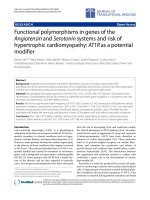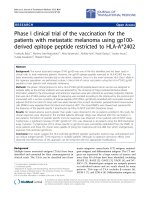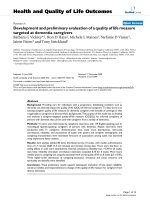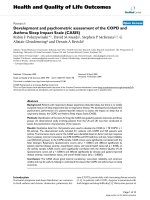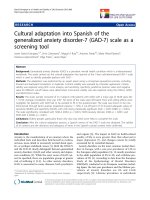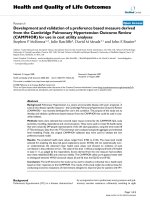báo cáo hóa học: " Development and psychometric assessment of the COPD and Asthma Sleep Impact Scale (CASIS)" pdf
Bạn đang xem bản rút gọn của tài liệu. Xem và tải ngay bản đầy đủ của tài liệu tại đây (286.98 KB, 10 trang )
BioMed Central
Page 1 of 10
(page number not for citation purposes)
Health and Quality of Life Outcomes
Open Access
Research
Development and psychometric assessment of the COPD and
Asthma Sleep Impact Scale (CASIS)
Robin F Pokrzywinski*
1
, David M Meads
2
, Stephen P McKenna
2,3
, G
Alistair Glendenning
4
and Dennis A Revicki
1
Address:
1
United BioSource Corporation, Bethesda, MD, USA,
2
Health Outcomes Research, Galen Research, Manchester, UK,
3
Department of
Psychology, University of Central Lancashire, Preston, UK and
4
Novartis Research Center, Horsham, UK
Email: Robin F Pokrzywinski* - ; David M Meads - ;
Stephen P McKenna - ; G Alistair Glendenning - ;
Dennis A Revicki -
* Corresponding author
Abstract
Background: Patients with respiratory disease experience disturbed sleep, but there is no widely
accepted measure of sleep impairment due to respiratory disease. We developed and evaluated the
psychometric performance of a patient-reported measure to assess the impact on sleep due to
respiratory disease, the COPD and Asthma Sleep Impact Scale (CASIS).
Methods: Identification of the items forming the CASIS was guided by patient interviews and focus
groups. An observational study involving patients from the US and UK was then conducted to
assess the psychometric characteristics of the measure.
Results: Qualitative data from 162 patients were used to develop the CASIS (n = 78 COPD; n =
84 asthma). The observational study included 311 patients with COPD and 324 patients with
asthma. The final seven items used in the CASIS were identified based on factor and item response
theory analyses. Internal consistency was 0.90 (COPD) and 0.92 (asthma), and test-retest reliability
was 0.84 (both groups). In the COPD sample, CASIS scores were significantly correlated with the
Saint George's Respiratory Questionnaire scores (all p < 0.0001) and differed significantly by
patient-reported disease severity, exacerbation status, and overall health status (all p ≤ 0.005). In
the asthma sample, CASIS scores were significantly correlated with the Asthma Quality of Life
Questionnaire scores (all p < 0.0001) and differed significantly by clinician and patient-reported
disease severity, exacerbation status, and overall health status (all p ≤ 0.0005).
Conclusion: The CASIS shows good internal consistency, test-retest reliability, and construct
validity and may be useful in helping to understand the impact that COPD and asthma have on sleep
outcomes.
Introduction
Nocturnal symptoms and sleep disturbance are common
in both asthma and chronic obstructive pulmonary dis-
ease (COPD), particularly with increasing disease severity
[1-3]. In patients with COPD, dyspnea is associated with
both fatigue and sleep difficulty [3]. Thirty-nine percent of
Published: 7 December 2009
Health and Quality of Life Outcomes 2009, 7:98 doi:10.1186/1477-7525-7-98
Received: 30 April 2009
Accepted: 7 December 2009
This article is available from: />© 2009 Pokrzywinski et al; licensee BioMed Central Ltd.
This is an Open Access article distributed under the terms of the Creative Commons Attribution License ( />),
which permits unrestricted use, distribution, and reproduction in any medium, provided the original work is properly cited.
Health and Quality of Life Outcomes 2009, 7:98 />Page 2 of 10
(page number not for citation purposes)
individuals with cough or wheeze in the general popula-
tion report having problems initiating or maintaining
sleep, and this rate increases to 53% in those with both
cough and wheeze [4]. In epidemiologic studies, more
than 50% of patients with COPD complained of difficulty
maintaining and initiating sleep, and 25% complained of
excessive daytime sleepiness [5,6]. Patients with asthma
also report increased sleep-related disturbances [2]. Eld-
erly patients with asthma reported poorer quality of sleep
than elderly patients with no respiratory disease [7].
Information on sleep-related outcomes is important to
help understand the impact of disease in patients with
asthma or COPD, yet until now these outcomes have been
challenging to measure. Although there are several sleep-
related measures [8-10], these measures are not specific to
respiratory diseases. For example, the Pittsburg Sleep
Quality Index [8] covers several relevant aspects of sleep
disturbance, but includes other items (e.g., bad dreams,
get up to use bathroom) which may not be associated
with asthma or COPD. In addition, daily diaries have
been used to track sleep difficulty [11], daytime sleepiness
and tiredness, difficulty maintaining sleep, early morning
awakenings [12], sleep disturbance [13-15], and sleep
symptoms [16]. However, each measures only selective
aspects of sleep, and it is difficult to compare results
between studies. A patient-reported outcome measure tar-
geting sleep impairment in patients with asthma or COPD
would complement existing health outcome measures
and extend our understanding of the impact of respiratory
disease symptoms on sleep impact and quality.
Given the prevalence of sleep problems in patients with
asthma or COPD and the absence of respiratory-specific
sleep measures, a new measure of sleep problems and
impairment was developed, the COPD and Asthma Sleep
Impact Scale (CASIS). The CASIS was intended to be brief,
patient-centered, and sufficiently comprehensive to cap-
ture the sleep problems experienced by patients with res-
piratory disease.
Methods
The CASIS was developed in three stages: (1) qualitative
research to identify the conceptual framework and items
in the measure; (2) cognitive interviewing to ensure
patient understanding; and (3) psychometric analysis to
evaluate the reliability and validity of the CASIS. Each
stage was executed in the US and UK. Relevant IRB and
ethics committee approvals were obtained, and all partic-
ipating patients provided written informed consent. We
outline here the methods and results of the first two stages
before fully describing the methods for the psychometric
analysis.
Stage 1: Qualitative Research to Identify Conceptual
Framework and Item Content
Four focus groups were conducted in the US, two among
patients with COPD and two among patients with
asthma. One-on-one interviews were conducted in the
UK. In total 43 patients with COPD and 55 patients with
asthma participated in the qualitative research (Table 1).
Content analysis of patient comments was used to iden-
tify key concepts and item content relating to nocturnal
symptoms (i.e., coughing, difficulty breathing, etc.), trou-
ble falling and remaining asleep, waking during the night,
disturbed sleep, feeling tired and not rested when waking
up, and worsening respiratory symptoms during the
night. The initial 20-item draft CASIS was generated based
directly on patient actual statements. Draft questions were
reviewed to ensure that they were relevant for US and UK
English. A five-level response scale was developed ranging
from 1 = none of the time to 5 = all of the time.
Stage 2: Cognitive Debriefing Interviews
Individual interviews in the US and UK were conducted to
assess respondent comprehension of the 20-item draft
CASIS. Thirty-five patients with COPD and 29 patients
with asthma were interviewed (Table 1). Based on this
qualitative research, several items were modified, and five
items that were not well-understood or redundant were
removed, resulting in a 15-item CASIS. The response
options were revised to range from 1 = never to 5 = very
often. This revised 15-item CASIS was then used in the
psychometric evaluation study.
Stage 3: Psychometric Evaluation Study
Study Design
An observational study was designed and conducted
among patients with either COPD or asthma from the US
and UK with the objective of evaluating item performance
and psychometric properties of the CASIS. The CASIS was
completed along with other selected patient-reported out-
comes (PRO) instruments. Inclusion criteria for the study
were: (1) a clinical diagnosis of COPD or asthma; (2) age
18 years or older; and (3) willingness to provide consent
to participate. Patients were excluded if they had both
asthma and COPD; had a severe comorbid chronic medi-
cal conditions perceived to be unstable by the principal
investigator (e.g., congestive heart failure, diabetes, schiz-
ophrenia, depression, etc.); or, in the investigator's judg-
ment, had cognitive impairments or other conditions that
would make study participation difficult. All patients
completed a baseline study visit, and a subset of US
patients completed the second visit within two weeks (10-
14 days) of the baseline visit. All UK patients completed a
mail survey at baseline, with a follow-up mail survey two
weeks later.
Health and Quality of Life Outcomes 2009, 7:98 />Page 3 of 10
(page number not for citation purposes)
Table 1: Demographic Characteristics and Health Status for Asthma and COPD Sample
Characteristics Focus group/interview sample Cognitive debriefing interview
sample
Validation sample
Asthma (n = 55) COPD (n = 43) Asthma (n = 29) COPD
(n = 35)
Asthma
(N = 324)
COPD (N = 311)
Age(years)
Mean (SD) 45.2 (17) 66.0 (11) 49.6 (17) 65.2 (9) 48.1 (16) 70.6 (10)
Range 22-82 33-91 18-82 48-80 18-85 45-95
Male n (%) 22 (40) 24 (56) 12 (41) 17 (49) 90 (28) 141 (45)
Years since
diagnosis
Mean (SD) 20.4 (14)
a
11.2 (11) 22.3 (16) 11.5 (14) 20.1 (15) 10.5 (11)
Range 1-68 1-50 1-60 1-60 1-71 1-76
Missing, n (%) 1 (2) 1 (2) 1 (3) 3 (9)
Participant-
reported disease
severity, n (%)
b, c
Mild 27 (49) 7 (16) 9 (56) 7 (37) 146 (45) 52 (17)
Moderate 14 (25) 16 (37) 6 (38) 4 (21) 120 (37) 139 (45)
Quite severe 10 (18) 12 (28) 1 (6) 5 (26) 43 (13) 93 (30)
Very severe 3 (5) 5 (12) 0 2 (11) 11 (3) 26 (8)
Missing 1 (2) 3 (7) 0 1 (5)
Participant-
reported overall
health, n (%)
d
Very good 5 (13) 0 2 (13) 0 46 (14) 14 (5)
Good 14 (36) 12 (41) 8 (50) 6 (32) 144 (44) 78 (25)
Fair 15 (38) 6 (21) 4 (25) 7 (37) 104 (32) 137 (44)
Poor 5 (13) 11 (38) 2 (13) 6 (32) 27 (8) 78 (25)
SGRQ
e
Mean (SD)
Symptom score 57.7 (22.2)
Activity score 73.3 (23.3)
Impacts score 43.6 (25.0)
Total score 54.7 (21.7)
AQLQ
f
Mean (SD)
Symptoms 4.7 (1.4)
Activity limitation 5.0 (1.4)
Emotional
function
4.9 (1.6)
Environmental
stimuli
4.6 (1.6)
Overall 4.8 (1.3)
a
3 asthma participants excluded from mean calculation were diagnosed in early childhood/infancy.
b
Clinician-reported for focus group asthma and COPD samples (US only)
c
Cognitive debriefing interview sample collected in UK only: asthma n = 16; COPD n = 19
d
Focus group/interview samples collected in UK only: asthma n = 39; COPD n = 29. Cognitive debriefing interview samples collected in UK only:
asthma n = 16; COPD n = 19
e
Scores range from 0 to 100 with higher scores reflecting more impairment. COPD participants only.
f
Scores range from 1 to 7 with higher scores reflecting more favorable health status. Asthma participants only.
Health and Quality of Life Outcomes 2009, 7:98 />Page 4 of 10
(page number not for citation purposes)
Health Outcome Measures
All patients completed a demographic form at baseline
and a change in health status form at the follow-up visit.
All patients rated their disease severity (mild, moderate,
severe) and general health status (poor, fair, good, very
good). In the US, clinicians rated disease severity (mild,
moderate, severe) and exacerbations during the previous
month. At baseline, the COPD patients reported whether
they used oxygen and the number of "bad days" due to
their disease during the previous week.
The CASIS was administered at two time points. Patients
with COPD completed the St. George's Respiratory Ques-
tionnaire (SGRQ) [17] and the Living with Chronic
Obstructive Pulmonary Disease Questionnaire (LCOPD;
McKenna SP, Meads DM, Doward LC, Pokrzywinski RF,
Revicki DA, Hunter CJ, Glendenning GA: Development
and validation of the Living with Chronic Obstructive Pul-
monary Disease [LCOPD] Questionnaire, submitted) dur-
ing their baseline visit or survey. Patients with asthma
completed the Asthma Quality of Life Questionnaire
(AQLQ) [18], and the Asthma Life Impact Scale (ALIS)
(Meads DM, McKenna SP, Doward LC, Pokrzywinski RF,
Revicki DA, Hunter CJ, Glendenning GA: Development
and validation of the Asthma Life Impact Scale [ALIS],
submitted) during the baseline visit or survey.
COPD and Asthma Sleep Impact Scale
The 15-item CASIS incorporated items on sleep impair-
ment associated with respiratory disease and breathing
problems. The response options ranged from 1 = never to
5 = very often, and several items are reverse-scored. The
item scores were summed together to arrive at a total raw
score. CASIS raw scores were linearly transformed to a 0-
100 total scale score. Recall time period for the measure
was the previous week, with higher scores indicating
greater sleep impairment.
St. George's Respiratory Questionnaire
The SGRQ is a self-administered instrument that assesses
the health status of patients with COPD or other chronic
airflow limitations [17]. The SGRQ is commonly used in
COPD research studies and has evidence supporting relia-
bility, validity, and responsiveness [17].
Living with Chronic Obstructive Pulmonary Disease Questionnaire
The LCOPD is a measure developed to assess the daily
impact of living with COPD (McKenna SP, Meads DM,
Doward LC, Pokrzywinski RF, Revicki DA, Hunter CJ,
Glendenning GA: Development and validation of the Liv-
ing with Chronic Obstructive Pulmonary Disease
[LCOPD] Questionnaire, submitted). For the LCOPD,
higher scores represent greater impairment to quality of
life.
Asthma Quality of Life Questionnaire
The standardized AQLQ is a self-administered asthma-
specific health-related quality of life (HRQL) instrument
that is widely used to assess outcomes in asthma [18]. The
AQLQ has good evidence supporting reliability, validity,
and responsiveness and is widely used for measuring
HRQL in adults with asthma [18].
Asthma Life Impact Scale
The ALIS is a measure developed to assess the daily impact
on patients of living with asthma (Meads DM, McKenna
SP, Doward LC, Pokrzywinski RF, Revicki DA, Hunter CJ,
Glendenning GA: Development and validation of the
Asthma Life Impact Scale [ALIS], submitted). For the ALIS,
higher scores represent a greater impairment of asthma on
the quality of life.
Psychometric Analyses
Psychometric analyses and item response theory (IRT)
analysis examined item performance [19,20]. After the
final CASIS items were determined then the reliability and
validity of the measure was evaluated [21]. All data analy-
ses were performed using SAS statistical software version
9.1 (Cary, NC) and Multilog [22].
Item Performance and Reduction
Item analyses used to evaluate the CASIS included item-
to-item correlations using Pearson's correlations, factor
analyses, and IRT analyses. The factor analyses were used
to examine the unidimensionality of the CASIS items (i.e.,
measures a single construct), and the IRT analysis evalu-
ated item performance. Differential item functioning
(DIF) was conducted to evaluate whether there were dif-
ferences in item responses by disease or country.
Reliability
Internal consistency reliability was measured using Cron-
bach's alpha [23]. Intraclass correlations (ICC), Pearson's
correlations, and change scores between the baseline and
follow-up were used to evaluate test-retest reliability and
stability of the CASIS scores. The ICC was estimated using
a fixed-effects analysis of variance (ANOVA) model [24].
ICCs greater than 0.70 are acceptable for group compari-
sons [24].
Construct and Known Groups Validity
Spearman correlations were used to evaluate construct
validity of the CASIS through correlations between base-
line CASIS scores and overall health status, SGRQ, and
LCOPD scores in the COPD sample and between CASIS
scores and overall health status, ALIS, and AQLQ scores in
the asthma sample [25]. Moderate correlations between
the CASIS and the disease-specific PRO measures were
expected (i.e., r = 0.30-0.60).
Health and Quality of Life Outcomes 2009, 7:98 />Page 5 of 10
(page number not for citation purposes)
To examine known groups validity by disease severity,
participants were stratified according to the clinician-rated
and patient-rated disease severity (i.e., mild, moderate,
severe). Mean CASIS scores were compared by severity,
overall health rating (i.e., poor, fair, good, very good), and
exacerbation status using ANOVA.
Results
Six hundred and thirty-five patients were enrolled in the
observational study in the US (n = 333) and UK (n = 302).
Of the participants, 311 were diagnosed with COPD and
324 with asthma (Table 1).
Item Performance and Reduction
There were minimal missing data for the items (<2.5%),
and the entire range of response options was used. There
were minimal ceiling effects and four items with floor
effects (lowest response > 30%). Nine items were highly
correlated (r ≥ 0.75) with other items indicating item
redundancy.
A 1-factor exploratory factor analysis was completed for
the asthma and COPD samples separately. Inspection of
the factor loadings indicated that they were similar across
the COPD and asthma samples (data not shown).
For the 15 items, IRT analyses were conducted separately
using the combined sample, COPD sample, and asthma
sample. For the combined sample, slope coefficients for
the IRT grade response model ranged from 4.06 to 1.65
(data not shown). The slope coefficients reflect the
strength of the association between the individual items
and the underlying contract, in this case sleep impair-
ment. Based on the IRT analyses, CASIS item responses
represented good coverage of the concept sleep impair-
ment based on a review of the category threshold param-
eters. The IRT analyses of the COPD and the asthma
samples were similar.
Based on the item analyses, we removed eight items. Four
items were removed due to redundancy and four based on
floor effects and redundancy. The psychometric character-
istics were determined for the final seven-item CASIS (see
Additional File 1).
A confirmatory factor analysis was performed using the
combined sample restricted to the seven items selected for
the final CASIS. In the COPD and asthma samples, the
single factor solution explained 58% (in COPD) to 62%
(in asthma) of the variance in the items. Factor loadings
were comparable across the two samples (data not
shown) confirming the unidimensional structure of the
CASIS items across disease groups. DIF analyses indicated
no significant differences in the pattern of responses to
CASIS items by disease or country (data not shown).
Reliability
Internal consistency reliability for the CASIS was 0.91,
0.90, and 0.92 for the combined, COPD, and asthma
samples, respectively. Test-retest reliability was assessed in
the sub-sample of participants who reported no change in
their health between the initial and follow-up assessments
(COPD: n = 112; Asthma: n = 61). The ICCs were 0.84 in
both groups (Table 2).
Validity
For the COPD sample, there were significant correlations
between CASIS scores and number of bad days (r = 0.61,
p < 0.0001), overall health status (r = 0.50, p < 0.0001),
LCOPD (r = 0.58, p < 0.0001), the SGRQ total score (r =
0.68, p < 0.0001) and SGRQ domain scores (r = 0.53 to
0.65, all p < 0.0001) (Table 3). For the asthma sample, sig-
nificant correlations were found between CASIS scores
and overall health status (r = 0.48, p < 0.0001), ALIS (r =
0.59, p < 0.0001), and AQLQ overall score (r = -0.72, p <
0.0001) and domain scores (r = -0.49 to -0.75, p <
0.0001) (Table 4).
Participants were stratified by clinician-reported severity
(Figure 1), patient-reported severity (Figure 2), exacerba-
tion status (Figure 3), and overall health status (Figure 4).
In the COPD sample, mean CASIS scores differed signifi-
cantly by patient-reported severity (p < 0.0001), exacerba-
tion status (p = 0.0021), and overall health status (p <
0.0001), but not clinician-rated severity (p = 0.0964).
Based on clinician-rated severity, there were clear differ-
ences between the mild and moderate or severe groups,
but not between the moderate and severe COPD groups
(Figure 1). Mean CASIS scores were significantly more
impaired in those patients with COPD receiving oxygen
Table 2: Test-retest Reliability for the CASIS Scores in Stable Patients with Asthma or COPD
CASIS N Visit 1 Mean (SD) Visit 2 Mean (SD) Difference Score P-Value
1
Pearson's r
2
ICC
3
COPD Participants 112 47.1 (24.0) 45.7 (23.5) -1.5 0.2443 0.85 0.84
Asthma Participants 61 44.8 (27.2) 42.0 (26.6) -2.7 0.1703 0.84 0.84
1
Paired t-tests comparing responses at baseline and follow-up
2
Pearson product moment correlations
3
Intraclass correlation coefficient
Health and Quality of Life Outcomes 2009, 7:98 />Page 6 of 10
(page number not for citation purposes)
(mean = 51.4; SD = 23.1 versus mean = 43.3; SD = 24.7, p
= 0.004). In the asthma sample, mean CASIS scores dif-
fered significantly by clinician-rated severity (p = 0.0004),
patient-reported severity (p < 0.0001), exacerbation status
(p < 0.0001), and overall health status (p < 0.0001).
Discussion
Focus groups and patient interviews generated the item
content for the CASIS, and information from cognitive
interviews was used to refine the CASIS. Psychometric
analyses based on a sample of 635 patients with either
asthma or COPD were used to finalize the item content
and to evaluate reliability and validity.
Based on the factor analyses and the IRT analyses, there
was evidence to show that the scale measures one con-
struct in this case, sleep impairment due to respiratory
disease. Analyses also demonstrated that the CASIS items
performs in a similar way in the US and UK and in
patients with COPD or asthma. This finding may be justi-
fied because although there are clinical differences in the
disease experience between asthma and COPD, the CASIS
was designed to assess the impact of this disease experi-
ence on sleep related outcomes.
The CASIS demonstrated excellent internal consistency
reliability (> 0.90) and very good test-retest reliability (>
0.80). These reliability statistics exceed commonly
accepted criteria for group data and therefore indicate that
the CASIS has good reliability [21,26].
Construct validity of the CASIS scores was demonstrated
through evaluation of correlations with other relevant
PRO measures in the COPD and asthma samples. As
expected, moderate to large significant correlations
between CASIS scores and the PRO measures were
observed. Greater sleep impairment was associated with
greater levels of impaired activities, symptoms, and
poorer quality of life for the COPD sample and greater
levels of impaired activities, symptoms, social function-
ing, and poorer quality of life scores for the asthma sam-
ple. The construct validity results suggest COPD and
asthma symptoms impact sleep and are related to
impaired health status and HRQL.
CASIS scores significantly differed between levels of self-
reported severity, self-reported overall health, and exacer-
bation status for COPD patients. In addition, CASIS
scores were significantly more impaired in patients with
COPD receiving oxygen compared with those not receiv-
ing oxygen. The CASIS was not able to significantly distin-
guish between clinician-reported severity levels for
patients with COPD. However, there was a clear differen-
tiation between the mild and moderate to severe COPD
groups, but not between the moderate and severe groups.
A possible reason could be the lack of lung volume cut
points for the clinician ratings, and variability in clinician
definitions of moderate and severe COPD. In addition,
patient-rated and clinician-rated severity differed and this
may be the source of non-significant differences in the
COPD group. We found agreement between clinician-
rated severity and patient-rated severity with a kappa sta-
tistic of 0.39 in the COPD sample and 0.45 for the asthma
sample. In the asthma group, the CASIS was able to signif-
icantly distinguish between clinician-rated and patient-
rated severity, overall health, and exacerbation status for
patients with asthma. The ability of the CASIS to differen-
tiate by disease severity and overall health status suggest
that the CASIS may be sensitive to change in clinical sever-
ity.
The CASIS uses a one-week recall period, and this recall
period was consistent with the preferences of the patients
in our study. A one-week recall period allows for a broader
experience to be captured given the varied impact of respi-
ratory symptoms on sleep problems. This recall period is
also consistent with the recently developed symptom and
functional outcomes, including sleep/wake function, for
the Patient Reported Outcome Measurement Information
System [27].
Table 3: Correlations Between CASIS and Other PRO Measures-
-COPD Sample: Baseline Data
PRO Measure Spearman Correlation
Number of bad days
1
0.61
Overall Health Status 0.50
LCOPD 0.58
SGRQ Symptoms 0.57
SGRQ Activities 0.53
SGRQ Impact 0.65
SGRQ Total Score 0.68
1
Number of bad days in the past week
All correlations significant at p < 0.0001
Table 4: Correlations Between CASIS and Other PRO Measures-
-Asthma Sample: Baseline Data
PRO Measure Spearman's Correlation
Overall Health Status 0.48
ALIS 0.59
AQLQ Symptoms -0.75
AQLQ Activity Limitation -0.68
AQLQ Emotional Function -0.59
AQLQ Environmental Stimuli -0.49
AQLQ Overall Score -0.72
All correlations significant at p < 0.0001
Health and Quality of Life Outcomes 2009, 7:98 />Page 7 of 10
(page number not for citation purposes)
Mean CASIS Scores by Clinician-reported Severity*Figure 1
Mean CASIS Scores by Clinician-reported Severity*.
0
10
20
30
40
50
60
70
Mild Moderate Severe
Clinician-Reported Severity
Mean CASIS Score
COPD
Asthma
* US Data only; COPD p=0.0964; Asthma p=0.0004
Mean CASIS Scores by Patient-reported Severity*Figure 2
Mean CASIS Scores by Patient-reported Severity*.
0
10
20
30
40
50
60
70
80
90
Mild Moderate Severe
Patient-Reported Severity
Mean CASIS Score
COPD
Asthma
* Combined US and UK data; COPD and Asthma samples p<0.0001
Health and Quality of Life Outcomes 2009, 7:98 />Page 8 of 10
(page number not for citation purposes)
Mean CASIS Scores by Exacerbation Status*Figure 3
Mean CASIS Scores by Exacerbation Status*.
0
10
20
30
40
50
60
70
80
COPD Asthma
Exacerbation Status
Mean CASIS Score
No
Yes
*US data only; COPD p=0.0021; Asthma p<0.0001
Patient-reported Overall Health*Figure 4
Patient-reported Overall Health*.
0
10
20
30
40
50
60
70
80
COPD Asthma
Patient-Reported Overall Health
Mean CASIS Score
Very Good
Good
Fair
Poor
* Combined US and UK data; COPD and Asthma samples p<0.0001
Health and Quality of Life Outcomes 2009, 7:98 />Page 9 of 10
(page number not for citation purposes)
Several study limitations should be considered when
interpreting these results. First, the generalizability of the
psychometric evaluation to the larger COPD and asthma
population may be limited given that we excluded
patients with unstable chronic medical conditions. Sec-
ond, there is no evidence as to the responsiveness of the
CASIS to changes in clinical status and this should be eval-
uated in future research. Previous research, however, sug-
gests that PRO instruments that demonstrate good known
groups validity also tend to demonstrate responsiveness
[26]. The CASIS was highly successful in discriminating
based on exacerbation status, patient-reported severity,
patient-reported overall health, and clinician-reported
severity (asthma group only). Clinician-reported severity,
for the COPD sample, did not reach statistical significance
so future research is needed to address this potential lim-
itation. Third, for some of the known group comparisons,
there were relatively small samples for some groups (i.e.,
exacerbations). Finally, pulmonary function or polysom-
nography measures were not collected, and future
research is needed to examine the relationship between
these clinical measures and the CASIS.
The CASIS was developed to measure sleep impairment
associated with respiratory disease, specifically asthma
and COPD. This new instrument provides a respiratory
disease-specific measure of sleep impairment that can
complement more generic sleep problem measures. The
CASIS differs from more generic sleep measures because it
was developed by focusing on the experience of patients
with either asthma or COPD, excludes content targeted to
generic sleep deprivation (e.g., bad dreams, get up to use
bathroom, etc), and includes respiratory specific sleep
items (e.g., wake up at night with breathing problems,
etc.). The measure was developed simultaneously in the
US and the UK. The methods used to systematically
develop the CASIS contribute to the strength of this new
PRO measure. Based on the current study, there is good
evidence supporting the internal consistency reliability,
test-retest reliability, and concurrent and known groups
validity in patients with either asthma or COPD. The
CASIS may prove to be a useful measure of sleep impair-
ment due to respiratory disease and help to understand
the impact that COPD and asthma have on outcomes
related to sleep.
Abbreviations
ALIS: Asthma Life Impact Scale; ANOVA: Analysis of vari-
ance; AQLQ: Asthma Quality of Life Questionnaire;
CASIS: COPD and Asthma Sleep Impact Scale; COPD:
Chronic obstructive pulmonary disease; DIF: Differential
item functioning; HRQL: Health-related quality of life;
ICC: Intraclass correlation; IRT: Item response theory;
LCOPD: Living with Chronic Obstructive Pulmonary Dis-
ease Questionnaire; PRO: Patient-reported outcome;
SGRQ: St. George's Respiratory Questionnaire.
Competing interests
This research was supported by funding from Novartis.
DAR, RFP, DMM, and SPM receive research funding from
Novartis. GAG is an employee of Novartis.
Authors' contributions
RFP managed the US portion of the research study, includ-
ing developing protocols; site coordination; data collec-
tion; data oversight; and reporting of data. DMM
managed the UK portion of the research study, including
developing protocols; site coordination; data collection;
data oversight; and reporting of data. SPM served as Prin-
cipal Investigator and Research Leader for all UK activities,
including study design and direction, interpretation of
data; and reporting of data. GAG developed the concep-
tual need for such work in the area of health outcomes
research, contributed to the conceptual design and critical
content of the research study. DAR served as Principal
Investigator and Research Leader for all US activities,
including study design and direction, interpretation of
data; and reporting of data.
All authors have read and approved the final manuscript.
Additional material
Acknowledgements
This research was funded by Novartis Pharma AG, Basel, Switzerland.
Institution where work was performed: United BioSource Corporation.
References
1. Colice GL, Burgt JV, Song J, Stampone P, Thompson PJ: Categoriz-
ing asthma severity. Am J Respir Crit Care Med 1999,
160(6):1962-1967.
2. Mastronarde JG, Wise RA, Shade DM, Olopade CO, Scharf SM:
Sleep quality in asthma: results of a large prospective clinical
trial. J Asthma 2008, 45(3):183-189.
3. Reishtein JL: Relationship between symptoms and functional
performance in COPD. Res Nurs Health 2005, 28(1):39-47.
4. Klink ME, Dodge R, Quan SF: The relation of sleep complaints to
respiratory symptoms in a general population. Chest 1994,
105(1):151-154.
5. Gump DW: Chronic bronchitis: common and controversial.
Infect Dis Clin Pract 1996, 5:227-231.
6. Klink M, Quan SF: Prevalence of reported sleep disturbances in
a general adult population and their relationship to obstruc-
tive airways diseases. Chest 1987, 91(4):540-546.
Additional file 1
COPD and Asthma Sleep Impact Scale. This is the COPD and Asthma
Sleep Impact Scale referred to in the manuscript.
Click here for file
[ />7525-7-98-S1.DOC]
Publish with BioMed Central and every
scientist can read your work free of charge
"BioMed Central will be the most significant development for
disseminating the results of biomedical research in our lifetime."
Sir Paul Nurse, Cancer Research UK
Your research papers will be:
available free of charge to the entire biomedical community
peer reviewed and published immediately upon acceptance
cited in PubMed and archived on PubMed Central
yours — you keep the copyright
Submit your manuscript here:
/>BioMedcentral
Health and Quality of Life Outcomes 2009, 7:98 />Page 10 of 10
(page number not for citation purposes)
7. Antonelli Incalzi R, Pistelli R, Imperiale C, Catalano F, Scichilone N,
Bellia V: Effects of chronic airway disease on health status of
geriatric patients. Aging Clin Exp Res 2004, 16(1):26-33.
8. Buysse DJ, Reynolds CF, Monk TH, Berman SR, Kupfer DJ: The
Pittsburgh Sleep Quality Index: a new instrument for psychi-
atric practice and research. Psychiatry Res 1989, 28(2):193-213.
9. Ellis BW, Johns MW, Lancaster R, Raptopoulos P, Angelopoulos N,
Priest RG: The St. Mary's Hospital sleep questionnaire: a
study of reliability. Sleep 1981, 4(1):93-97.
10. Johns MW: A new method for measuring daytime sleepiness:
the Epworth sleepiness scale. Sleep 1991, 14(6):540-545.
11. Eigen H, Reid JJ, Dahl R, Del Bufalo C, Fasano L, Gunella G, Sahlstrom
KK, Alanko KL, Greenbaum J, Hagelund CH, et al.: Evaluation of
the addition of cromolyn sodium to bronchodilator mainte-
nance therapy in the long-term management of asthma. J
Allergy Clin Immunol 1987, 80(4):612-621.
12. Vir R, Bhagat R, Shah A: Sleep disturbances in clinically stable
young asthmatic adults. Ann Allergy Asthma Immunol 1997,
79(3):251-255.
13. Busse WW, Brazinsky S, Jacobson K, Stricker W, Schmitt K, Burgt J
Vanden, Donnell D, Hannon S, Colice GL: Efficacy response of
inhaled beclomethasone dipropionate in asthma is propor-
tional to dose and is improved by formulation with a new
propellant. J Allergy Clin Immunol 1999, 104(6):1215-1222.
14. Donohue JF, Kalberg C, Emmett A, Merchant K, Knobil K: A short-
term comparison of fluticasone propionate/salmeterol with
ipratropium bromide/albuterol for the treatment of COPD.
Treat Respir Med 2004, 3(3):173-181.
15. Tinkelman DG, Bleecker ER, Ramsdell J, Ekholm BP, Klinger NM, Col-
ice GL, Slade HB: Proventil HFA and ventolin have similar
safety profiles during regular use. Chest 1998, 113(2):290-296.
16. Yokoyama A, Kohno N, Sakai K, Hirasawa Y, Kondo K, Hiwada K:
Effect of pranlukast, a leukotriene receptor antagonist, in
patients with severe asthma refractory to corticosteroids. J
Asthma 1998, 35(1):57-62.
17. Jones PW, Quirk FH, Baveystock CM, Littlejohns P: A self-com-
plete measure of health status for chronic airflow limitation.
The St. George's Respiratory Questionnaire. Am Rev Respir Dis
1992, 145(6):1321-1327.
18. Juniper EF, Guyatt GH, Epstein RS, Ferrie PJ, Jaeschke R, Hiller TK:
Evaluation of impairment of health related quality of life in
asthma: development of a questionnaire for use in clinical
trials. Thorax 1992, 47(2):76-83.
19. Reeve BR, Fayers P: Applying item response theory modeling
for evaluating questionnaire item and scale properties. In
Assessing Quality of Life in Clinical Trials 2nd edition. Edited by: Fayers P,
Hays RD. New York: Oxford University Press; 2005:55-73.
20. Linden WJ Van der, Hambleton RK: Handbook of Modern Item
Response Theory New York: Springer-Velag; 1997.
21. Nunnally JC, Bernstein IH: Psychometric Theory 3rd edition. New York:
McGraw-Hill; 1994.
22. Thissen D, Chen WH, Bock D: MULTILOG Lincolnwood, IL: Scientific
Software International; 2002.
23. Cronbach LJ: Coefficient alpha and the internal structure of
tests. Psychometrika 1951, 16:297-334.
24. Deyo RA, Diehr P, Patrick DL: Reproducibility and responsive-
ness of health status measures. Statistics and strategies for
evaluation. Control Clin Trials 1991, 12(4 Suppl):142S-158S.
25. Hays WL: Statistics 4th edition. New York: Holt, Rinehart & Winston,
Inc; 1988.
26. Hays RD, Revicki DA: Reliability and validity, including respon-
siveness. In Assessing Quality of Life in Clinical Trials 2nd edition. Edited
by: Fayers P, Hays RD. New York: Oxford University Press; 2005.
27. Patient Reported Outcome Measurement Information Sys-
tem [
]. Accessed November 10, 2008

